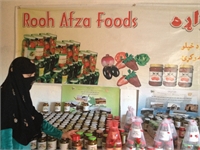
07 Jul The unseen role of women in Afghan Communities: A Journey through Jalalabad
Women in Afghan communities play a very important role in social, economic, political and cultural aspects of the life but this role is often unseen or not considering very important because women rarely appear in public spheres. In Afghan communities especially in the rural areas people says, women are not involved in economic aspects but in reality, women are having a very important but unseen role in the market or economic life. If we search about the role of women in the market, we find that women involved in farming, storing, preparing or making of items but those are selling by men. The issue came into my attention when I traveled to one of the provinces of Afghanistan to do research for Afghanistan Research and Evaluation Unit (AREU) as part of Secure Livelihood Research Consortium (SLRC) with special focus on role of women in economic life.
Later, in the afternoon, I had an interview with a business woman whose talent and abilities impressed me. Her name is Hanifa and is a director for Rooh Afza Jam & Pickles factory and five other women are working with her. It was amazing for me to see how the women make jam and pickles from local products and the basic and very ordinary tools and machines they use to pack their products. The women run the factory and men take the products to market, as in Afghan society, some people belief that it’s better for women to stay inside the houses. As many women stay home, it is difficult to understand what role they do play in the community.
The next day I went to the Directorate of Women Affairs (DOWA) in Jalalabad city and I met the head of DoWA. I also met with other women working in the office with sympathy to change their future and the future of their children through the work they do for this country. They complained about the security situation and Afghan culture being against women’s work in the office or in public sphere. Those women are right, in Afghanistan; women are not only being prevented from their rights but had been sentencing to violence. According to UNFPA in Afghanistan “up to 87, 2 % of women experience at least one form of physical, sexual or psychological violence, or forced marriage, and up to 62, 0 %, experience multiple forms of violence†[2] , this is a big concern for women.
Ms. Anisa Amran has been working as head of Department of Women’s Affairs (DoWA) in Jalalabad city for four years and she told me about women’s achievements in the past ten years at Nangarhar province of Afghanistan. She is one of the five women in key positions in Nangarhar province, in the DoWA, head of Administrative Reform Commission Provincial Office, and the Regional Office of Afghan Independent Human Rights Commission, in Teacher Training and the Deputy Director of Health Provincial Department. About 3,000 women that are making rugs in Nangarhar and 45 women police that are working for security, 300,000 girls are going to schools and 600 are studying in government universities, which is very important for strengthening the roles of women in the community.
Ms. Zia Gul is another working woman. She has been an Economic Officer with DoWA for 10 years. Ms. Zia Gul is also studying to become a teacher, part-time. She implements the duties of DoWA director in her absence and other activities related to her department. She said, she is a mother, her husband is also a government employee, and her salary is a big support to her family, similar to her other women in Nangarhar provides best support to their families their through the paid work or unpaid work (house chores) that they implement.
I also met a number of women running small business in Jalalabad city, those who formed the union of Nangarhar business women, which consists of a managing body and ten members. Each of these women is director of a factory, where many other women work. In addition, I visited farmer women and I saw how they work on the farms and play an important role in farming progress and improvement of agriculture in the community.
In my visit to Jalalabad, I could see another dimension of how women vitally contribute to Afghan communities, even through their roles often remain invisible and untold. The example of Nangarhar suggests that while Afghan women are increasingly empowered and are contributing to their community and families livelihood, but their role has still remain unacknowledged by the society, by the public officials and even by media. They do much more and therefore, they deserve more and better recognition.
References:
[1] – Nangarhar province is located on the eastern side of Afghanistan bordering Kunar and Laghman provinces to the North, Kabul, Logar and Paktya in the West, and an international border with Pakistan in the East and South. for more information visit the link bellow:
http://www.foodsecurityatlas.org/afg/country/provincial-Profile/Nangarhar
[2] – http://countryoffice.unfpa.org/afghanistan/2011/11/13/4196/gender_health_response_to_gender_based_violence/

